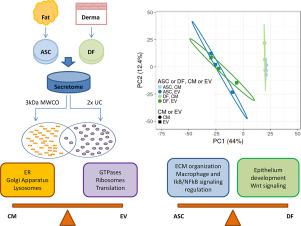Journal of Proteomics ( IF 3.3 ) Pub Date : 2020-12-10 , DOI: 10.1016/j.jprot.2020.104069 Stefania Niada 1 , Chiara Giannasi 1 , Cinzia Magagnotti 2 , Annapaola Andolfo 2 , Anna Teresa Brini 3

|
Conditioned medium (CM) and extracellular vesicles (EV) from Adipose-derived Stem/stromal cells (ASC) and Dermal fibroblasts (DF) represent promising tools for therapeutic applications. Which one should be preferred is still under debate and no direct comparison of their proteome has been reported yet. Here, we apply quantitative proteomics to explore the protein composition of CM and EV from the two cell types. Data are available via ProteomeXchange (identifier PXD020219). We identified 1977 proteins by LC-MS/MS proteomic analysis. Unsupervised clustering analysis and PCA recognized CM and EV as separate groups. We identified 68 and 201 CM and EV specific factors. CM were enriched in proteins of endoplasmic reticulum, Golgi apparatus and lysosomes, whereas EV contained a large amount of GTPases, ribosome and translation factors. The analysis of ASC and DF secretomes revealed the presence of cell type-specific proteins. ASC-CM and -EV carried factors involved in ECM organization and immunological regulation, respectively. Conversely, DF-CM and –EV were enriched in epithelium development associated factors and -EV in Wnt signaling factors. In conclusion, this analysis provides evidence of a different protein composition between CM and EV and of the presence of cell type-specific bioactive mediators suggesting their specific future use as advanced therapy medicinal products.
Significance
The use of cell secretome presents several advantages over cell therapy such as the lower risks associated to the administration step and the avoidance of any potential risk of malignant transformation. The main secretome preparations consist in concentrated conditioned medium (CM) and extracellular vesicles (EV). Both of them showed well-documented therapeutic potentials. However, it is still not clear in which case it should be better to use one preparation over the other and an exhaustive comparison between their proteome has not been performed yet. The choice of the cell source is another relevant aspect that still needs to be addressed. In order to shed light on these questions we explored the protein composition of CM and EV obtained from Adipose-derived Stem/stromal Cells (ASC) and Dermal Fibroblasts (DF), by a comprehensive quantitative proteomics approach. The analysis showed a clear distinction between CM and EV proteome. CM were enriched in proteins of endoplasmic reticulum, Golgi apparatus and lysosomes, whereas EV contained a large amount of GTPases, ribosome and translation-related factors. Furthermore, the analysis of ASC and DF secretomes revealed specific biological processes for the different cell products. ASC secretome presented factors involved in ECM organization (hyaluronan and glycosaminoglycan metabolism) and immunological regulation (e.g. macrophage and IkB/NFkB signaling regulation), respectively. On the other hand, DF-CM and –EV were both enriched in epithelium development associated factors, whilst DF-CM in proteins involved in cellular processes regulation and -EV in Wnt signaling factors. In conclusion, our study shed a light on the different protein composition of CM and EV of two promising cell types, spanning from basic processes involved in secretion to specific pathways supporting their therapeutic potential and their possible future use as advanced therapy medicinal products.
中文翻译:

人脂肪来源的干/基质细胞和真皮成纤维细胞对细胞外囊泡和条件培养基的蛋白质组学分析
来自脂肪干细胞/基质细胞(ASC)和真皮成纤维细胞(DF)的条件培养基(CM)和细胞外囊泡(EV)代表了有希望的治疗应用工具。哪一种是首选仍在争论中,尚未报道其蛋白质组的直接比较。在这里,我们应用定量蛋白质组学来探索两种细胞类型中CM和EV的蛋白质组成。数据可通过ProteomeXchange(标识符PXD020219)获得。我们通过LC-MS / MS蛋白质组学分析鉴定了1977种蛋白质。无监督聚类分析和PCA将CM和EV视为独立的组。我们确定了68和201 CM和EV的特定因素。CM富含内质网,高尔基体和溶酶体的蛋白质,而EV含有大量的GTPases,核糖体和翻译因子。ASC和DF分泌组的分析揭示了细胞类型特异性蛋白的存在。ASC-CM和-EV分别具有参与ECM组织和免疫调节的因素。相反,DF-CM和–EV富含上皮发育相关因子,而-EV富含Wnt信号因子。总之,该分析提供了CM和EV之间蛋白质组成不同的证据,以及细胞类型特异性生物活性介体的存在,表明它们将来有可能作为高级治疗药物使用。
意义
与细胞疗法相比,使用细胞分泌蛋白组具有一些优势,例如与给药步骤相关的较低风险以及避免了任何潜在的恶性转化风险。主要的分泌蛋白制剂包括浓缩的条件培养基(CM)和细胞外囊泡(EV)。他们俩都显示出有据可查的治疗潜力。然而,尚不清楚在哪种情况下使用一种制剂优于另一种制剂,并且尚未对其蛋白质组之间进行详尽的比较。小区源的选择是仍然需要解决的另一个相关方面。为了阐明这些问题,我们探讨了从脂肪干细胞/基质细胞(ASC)和真皮成纤维细胞(DF)获得的CM和EV的蛋白质组成,通过全面的定量蛋白质组学方法。分析表明CM和EV蛋白质组之间有明显区别。CM富含内质网,高尔基体和溶酶体的蛋白质,而EV含有大量的GTPases,核糖体和翻译相关因子。此外,对ASC和DF分泌组的分析揭示了不同细胞产物的特定生物学过程。ASC分泌基因组分别呈现参与ECM组织(透明质酸和糖胺聚糖代谢)和免疫调节(例如巨噬细胞和IkB / NFkB信号调节)的因素。另一方面,DF-CM和–EV均富含上皮细胞发育相关因子,而DF-CM的蛋白质参与细胞过程调节,而-EV的Wnt信号因子丰富。结论,



























 京公网安备 11010802027423号
京公网安备 11010802027423号